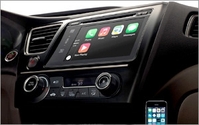 The
chief selling points for bringing Android and iOS into the dashboard of cars appear to be both consistency of interface as well as seamless connection with one’s own content. As was widely
reported earlier this week, Apple rolled out an updated and rebranded version of its earlier in-car iOS solution as CarPlay. Now we have the first glimpse of what the interface looks like at work.
The
chief selling points for bringing Android and iOS into the dashboard of cars appear to be both consistency of interface as well as seamless connection with one’s own content. As was widely
reported earlier this week, Apple rolled out an updated and rebranded version of its earlier in-car iOS solution as CarPlay. Now we have the first glimpse of what the interface looks like at work.
HMI & Apple Carplay Geneva Motorshow 2014 from Life in the City on Vimeo.
In this video from Life in the City at the Geneva Motorshow, an Apple representative walks
through the experience. Keep in mind in this iteration in a Volvo the touch interface is being emphasized. But in the installation demonstrated elsewhere with Mercedes-Benz, the Siri-based voice
command system is put forward.
advertisement
advertisement
The familiar Music, Maps, Messaging, Podcast and calling icons are all ported to the dashboard interface. In fact, a premium is placed here on maintaining
familiarity. As the spokesperson underscores, the user is plugging their own phone and content into the car. That means all of the contacts, email, music and user history is accessible here. It is
mainly the dashboard interaction that is different and optimized for easier touch interaction.
And here now is a good example where cross-platform integration of data really matters. Most
notable in the in-car enhancements in CarPlay’s is personalized mapping. The map search function knows your past searches, appointments, even addresses in recent email and messages. The
suggested destinations use predictive modeling to anticipate your likely target.
This is no small thing. For the last few years, most manufacturers have fought to maintain control of the
telematics experience. I once heard one auto marketer proclaim something to the effect of it being “our damned car,” not Apple’s or Google’s. Actually, it is the
consumer’s car, but the slip of the tongue seemed revealing of auto industry attitudes about who should own the cabin experience top to bottom. But consumers appear to have spoken in recent
years as we all have struggled with in-car infotainment systems.
I am not sure how much the automakers really are prepared to integrate iOS and Android into their entire line. But no one
of us wants to have to learn a new interface when we get in the car, let alone have to subscribe to discrete music. At this point automakers that make it hard for us to bring our mobile experiences
into the car with us just seem petty and obstructionist. They can whine all they like about needing to ensure driving-safe interfaces and control over the customer experience. All these ridiculous
proprietary interfaces are just getting in our way now. As far as I am concerned, Detroit should accept that smartphones win and get on with it already.